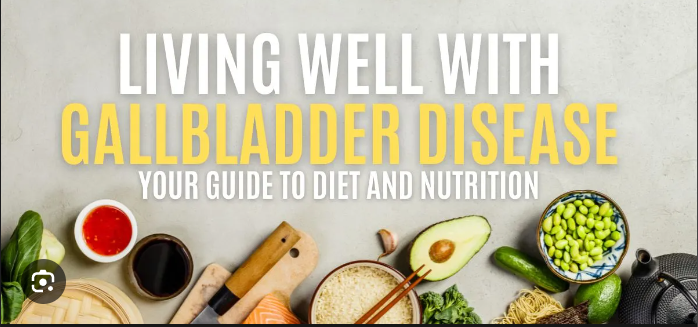Consuming a balanced diet rich in nutrients can help stave off gallbladder illness. On the other side, a diet high in foods that have undergone extreme processing may raise your risk for issues with your gallbladder.
A gastroenterologist in Western New York diagnosed Jackie Penna, an attorney, with gallstones after she complained of persistent stomach pain.
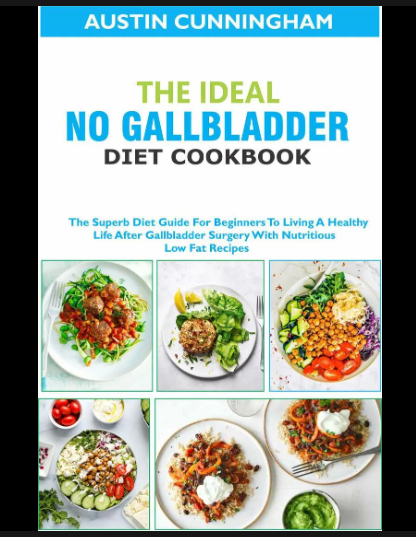
Also read-Potatoes: Are They Vegetables And Healthy?
Gallstones are solidified chunks of bilirubin or cholesterol that can clog the bile duct and hinder the gallbladder’s ability to function properly. While most gallstones dissolve on their own, smaller gallstones have a higher likelihood of passing through the bile duct and obstructing the flow of bile, which can result in a gallbladder attack or biliary colic, which is characterized by a sharp pain in the right section of your belly.
As a result, Penna’s physician advised having her gallbladder surgically removed during an outpatient procedure, known as a cholecystectomy. The surgeon advised her to adopt a diet that is good for her gallbladder in order to get ready for the procedure.
Although the majority of people, including Penna, are aware of heart-healthy meals, few individuals choose a diet designed especially for the little, pear-shaped organ. However, a diet rich in fruits, vegetables, whole grains, and lean proteins will help maintain a healthy gallbladder and ward off stomach pain brought on by gallstones.
“Gallbladder disease is common, but it’s an organ that most individuals don’t think a lot about until there’s a problem,” says Dr. Brooks D. Cash, chief of gastroenterology, hepatology and nutrition at the University of Texas Health Science Center at Houston.
Healthy Foods for the Gallbladder
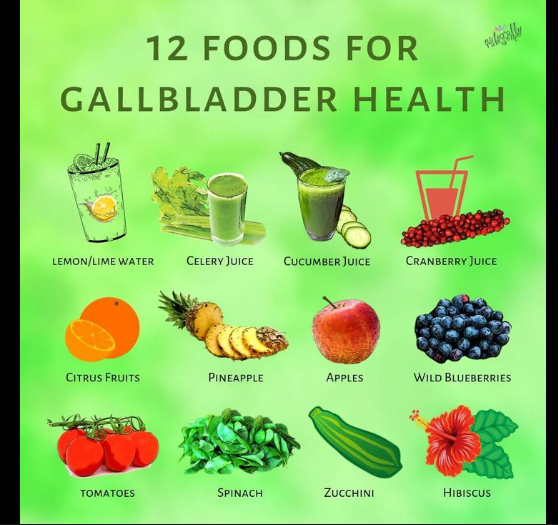
Maintaining a healthy weight and eating a diet low in saturated fat and cholesterol, moderate in calories, and high in fiber are crucial whether or not you are at risk for gallstones.
Foods that are good for the gallbladder include:
- Vegetables and fruits.
- Whole grains.
- Healthy protein.
- Wholesome fats.
Fruits and vegetables
One of the best strategies to enhance and maintain the health of any gallbladder is to eat a balanced diet rich in fruits and vegetables.
Fresh produce is always beneficial to your health, and the gallbladder is no exception. Fiber, minerals, and vitamins, such as vitamins C and E, abound in fruits and vegetables. Check out the produce area of your neighborhood grocery store or go to your neighborhood farmer’s market if you’re looking for foods to consume with gallbladder difficulties.
Fruits and veggies that are good for the gallbladder include:
- Arugula.
- Avocados.
- Beans.
- citrus fruit.
- Kale.
- Peas.
- Watercress.
Particularly bitter foods, like kale and watercress, are very beneficial for enhancing the function of the gallbladder.
Whole grains
According to Rachel Stefan, a registered dietitian with the Nutrition Clinic for Digestive Health in Atlanta, “my favorite ways to add those to a diet are to always go for a dark, bitter leafy green with a salad, adding herbs like dill and ginger when cooking, and using citrus fruits and peels for an afternoon tea or flavored water.”
- Barley.
- cereal containing bran.
- Dark rice.
- Bulgur.
- Oats.
- Quinoa.
- Whole grain bread.
Lean protein
Protein is a crucial component for aiding in bodily repair, but it’s recommended to stay away from foods high in protein that are also high in bad fats.
Options for lean protein include:
- Beans.
- Chickpeas.
- Lentils.
- Greek yogurt with less fat.
- Poultry, including turkey and chicken breast.
- Tofu.
Best Foods to Eat and Avoid for Your Gallbladder
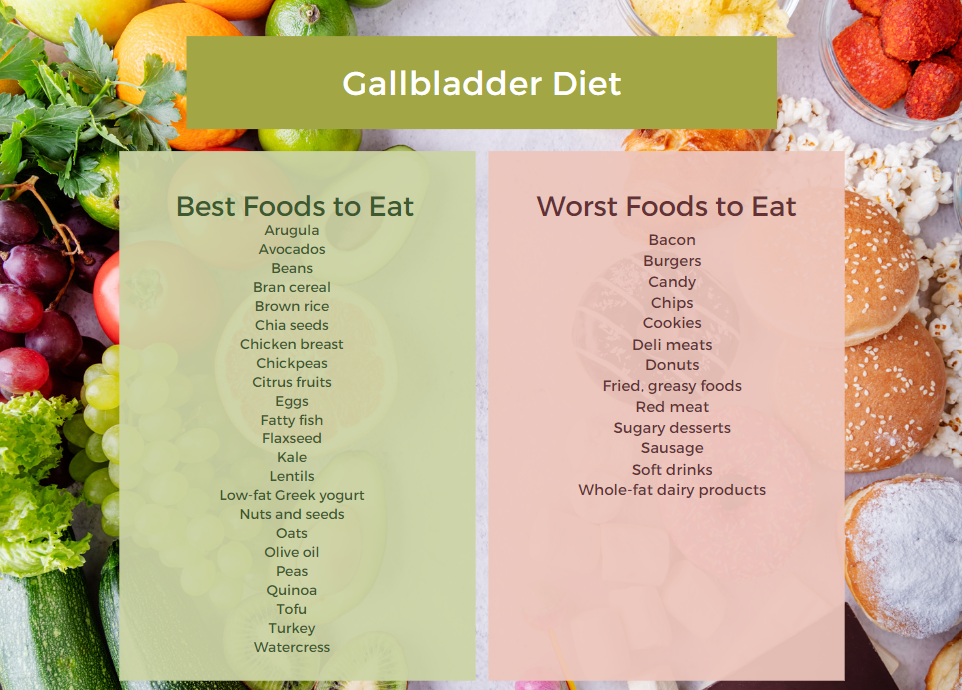
Foods to Avoid With Gallbladder Problems
According to researchers, a lot of gallbladder problems are caused by the Western diet’s excessive intake of refined carbohydrates, saturated fats, and trans fats, which encourage the development of gallstones.
According to Cash, when gallstone symptoms appear, it usually happens when the organ is trying to squeeze and some of the gallstone is obstructing the bile. “The bile can’t get through, so the squeezing causes pain.”
While changing your diet won’t get rid of gallstones that are already there, eating a healthy diet with a balanced variety of nutrients and limiting the amount of saturated fats and cholesterol-heavy foods may help ease symptoms or prevent future gallstones.
“That extra cholesterol can form into crystals that eventually form into gallstones,” he explains. “That’s why diet is so important and where people can make the biggest difference in how they maintain a healthy gallbladder.”
Try to avoid or limit these high-fat, sugar-laden foods in your diet:
- Fried food.
- Foods that have been heavily processed, such as deli meats, doughnuts, pies, and pastries.
- A red meat.
- Processed grains.
- Beverages that are softer.
- Foods high in sugar, such as pastries, candies, and cookies.
- Fairy goods with a high fat content, such as cheese, ice cream, and butter.
Gallbladder-Healthy Recipes
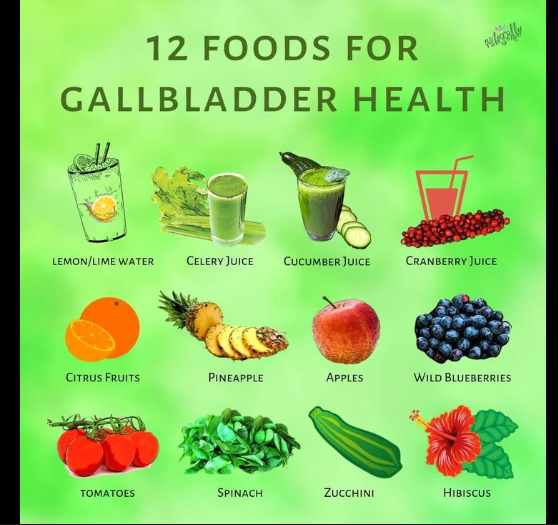
Stay on track with your dietary goals with these gallbladder-friendly main dishes. All recipes courtesy of Dr. Sandra Cabot.
Chicken and pepper stir-fry
A delicious, quick and simple low carb meal idea that combines chicken and fresh red peppers (serves four).
Ingredients:
- 1 pound ground chicken.
- 2 tablespoons olive oil.
- 1 red pepper (capsicum), sliced.
- 4 tablespoons fresh lemon juice.
- 1 handful roasted cashews.
- 1 tablespoon tamari or soy sauce or coconut aminos.
- 1 large handful fresh basil leaves, torn.
Directions:
- Heat the olive oil in a large skillet.
- Add the chicken to the skillet and stir fry it for a few minutes until cooked through.
- Add pepper.
- Stir fry for another few minutes and then add all other ingredients except the basil.
- Throw the torn basil in, stir it through and then take the food off the heat.
Low-carb lemon turkey breasts
Serves four.
Ingredients:
- 4 turkey breasts.
- ½ cup lemon juice.
- ¼ cup tahini.
- 2 tablespoons Dijon mustard.
- Salt and pepper to taste.
- Extra-virgin olive oil, ghee or duck fat for cooking turkey.
Directions:
- Heat oil or fat in a frying pan over medium heat. Season the turkey with salt and pepper.
- Place the turkey in the frying pan and cook for a few minutes.
- Combine all other ingredients together in a bowl. Turn the turkey over, pour sauce into the frying pan, reduce heat to low and cover the pan with a lid.
- Cook for approximately 20 minutes, or until the turkey is well cooked through.
Vegetarian quinoa pilaf
A delicious veg recipe low in fat, high in protein and easy to make. (serves four).
Ingredients:
- 4 cups vegetable stock.
- 2 cups quinoa.
- 2 tablespoons olive oil.
- 1 medium red pepper (capsicum), chopped.
- 1 medium yellow pepper (capsicum) chopped.
- 1 small head of broccoli chopped.
- 6 cherry tomatoes halved.
- 2 large carrots, thinly sliced.
- 2 medium zucchinis, chopped.
- 1 cup diced pumpkin.
- 1 brown onion, chopped.
- 1 tablespoon dried oregano.
- 1 teaspoon ground cumin.
- 2 tablespoons tomato paste.
- Salt and pepper, to taste.
Directions:
- Rinse the quinoa and cook it in a large pot in the vegetable stock for approximately 15 minutes, or until softened.
- Heat the olive oil in a large pot over medium heat. Sauté the onion for approximately 3 minutes, or until softened.
- Add all remaining ingredients except the quinoa.
- Stir and cook gently until the vegetables have softened. You may need to add some water if the vegetables are sticking to the bottom of the pot.
- Once cooked, add vegetable mixture to the quinoa mixture.
- Stir well and serve.
Also read-Is Pasta Healthy Or Unhealthy?
Images source-google







